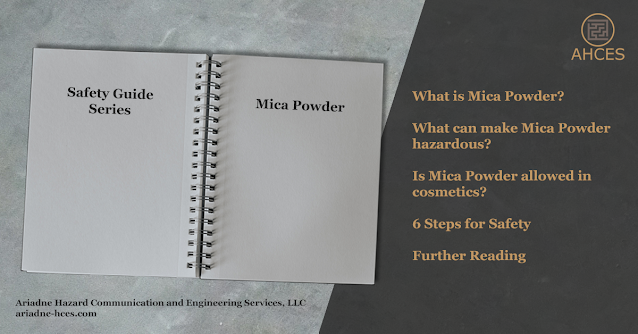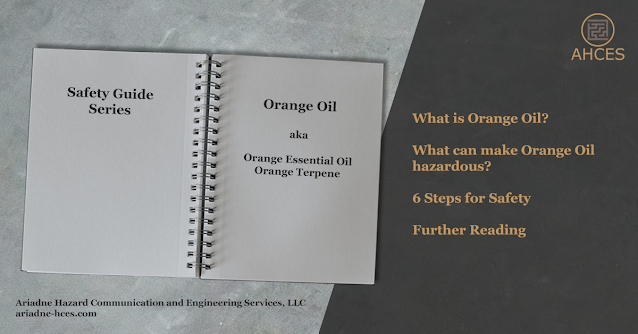Mica Powder Safety Guide
What is Mica Powder?
Mica is a group of natural hydrous silicate minerals noted for their lustrous shine, which makes it a popular additive in powder pigments. Mica can be found both in cosmetics and in artists' pigments used in painting, epoxy resin, soapmaking, and other crafts.
Mica groups several different naturally occurring hydrous silicate minerals, including the more common biotite and muscovite, as well as lepidolite, margarite, phlogopite, roscoelite, and zimmwaldite.
Mica has a CAS Number 12001-26-2.
The CAS Number is used to identify mica as an ingredient on safety data sheets (SDS) and other safety documentation. When looking for mica as an ingredient in pigments, colorants, finishes, or other materials, look for the CAS Number within the composition table.
Notable Properties of Mica Powder
Mica is most noted for its lustrous shine or shimmer due to the shape of the hydrous silicate crystals. It is naturally colorless and odorless, with any color or odor coming from natural impurities or other ingredients within a powder pigment.
What Can Make Mica Powder Hazardous?
Mica powder is a fine powder made of a silicate mineral. The crystal structure of the mica, the same property that gives it an attractive shimmer, also means the powder can damage your lungs if inhaled. In extreme cases, this could lead to Silicosis, which is a type of pulmonary fibrosis caused by accumulative damage to the lungs by silica crystals.
Mica powder is generally considered safe for consumers. The greatest hazard associated with mica powder is repeated exposure to workers, including cosmetics manufacturers and artists.
The National Institute for Occupational Safety and Health (NIOSH) has a Pocket Guide for mica. The primary hazard listed is respiratory system damage, with the symptoms being coughing, breathing difficulty, and muscle weakness or exhaustion. Mica powder is also listed as causing irritation to the skin and eyes.
Is Mica Powder Allowed in Cosmetics?
Yes, mica powder is permitted in cosmetics in the United States. The FDA has a List of Color Additives Permitted for Use in Cosmetics and mica powder is included.
Mica powder is a popular additive due to its shine as well as being considered a natural pigment. As a naturally derived product, some mica powder can contain impurities that may be harmful, including heavy metals such as lead, and care must be taken to obtain mica powder from reliable sources for use in cosmetics or other products meant to be used on humans.
Mica powder can also be synthesized, which has higher purity standards and does not have the same heavy metal contamination risk as natural mica. The other hazardous properties are still present in synthetic mica.
6 Steps for Safety
Step 1: Read the Warning
When working with a product for the first time, always read all safety documents first. This includes safety data sheets, which should be produced by the manufacturer or importer of the mica powder product. There may also be an OSHA chemical label, FDA cosmetics label, or a Consumer Protection label on the packaging of the mica powder product. These documents contain important information on the hazards of the product and instructions on how to mitigate those hazards.
Different compositions in different products may cause additional hazards to be present beyond the properties of plain mica powder. Be sure to familiarize yourself with the differences between separate mica powder products.
For example, copper carbonate, which is a bright turquoise mineral pigment, can cause contact allergies and should not be touched with bare skin. A pigment containing both copper carbonate and mica powder will have different safety precautions than plain mica powder.
Step 2: Prepare Your Workspace
Creating a safe workspace, sometimes referred to as engineering control, is a key component of working safely with any potentially hazardous substance.
Since the primary hazard of mica powder is the fine dust, either breathing it in or getting it in your eyes, ventilation is important. Fans that would blow mica powder around should be avoided. Dust collectors and air filters which draw in and capture any stray mica powder are ideal.
Step 3: Gather Your PPE
For working with plain mica powder, here is the recommended personal protective equipment (PPE):
- Respiratory Protection
- NIOSH Recommends a half-facepiece respirator with N95-rated filters for protection against airborne crystalline silica, such as mica powder.
- A full-facepiece respirator can serve as both respiratory protection and eye protection.
- Eye Protection
- Safety goggles that create a seal around the eyes are needed to prevent any airborne mica powder from reaching the eyes.
- Open safety glasses, which do not have a sealing surface, will not work in preventing dust from reaching the eyes.
- Gloves
- Basic disposable gloves will prevent mica powder from touching the skin on the hands and causing irritation.
- Plain mica powder does not have any known chemical interactions with the material used for most disposable gloves.
- Long Sleeves
- Long sleeves will prevent mica from touching the skin on the arms and causing irritation.
- Either a long-sleeved shirt, long-sleeved coat, or disposable sleeves will work.
- Launder any contaminated closing separately to prevent cross-contamination and inform anyone laundering the clothing of the presence of mica powder so they can take any necessary precautions.
Step 4: Clear Your Workspace
Having a clear workspace is an important part of safety. Clutter can cause accidents and can prevent you from noticing if something has spilled.
This is also a good time to double-check that any engineering controls, like a dust collector, are in proper working order and no filters need to be changed out.
If you are working in a shared space, make sure anyone around you can also remain safe when you are working with mica powder. For those working at home, this can include family members and pets. This may take the form of providing others with proper PPE or preventing them from accessing your workspace when mica powder is in use.
Step 5: Do The Work
Plain mica powder is inert. If engineering controls and PPE are used properly, working with mica powder has minimal hazards.
If work cannot be completed in one sitting, be sure to properly seal any mica powder container to prevent spills or accidental release when not in use.
Step 6: Clean Up
Dust generation should be avoided when cleaning up. Either a vacuum with a filter or a damp cleaning cloth can be used to pick up spilled or stray mica powder while preventing dust generation.
Be sure to dispose of any waste in accordance with local regulations, which can vary by State and county.
Further Reading
The National Library of Medicine has a PubChem Mica Compound Summary and Hazardous Substances Data Bank Entry.
ConsumerNotice.org has an excellent Silica Dust Informational Guide for more information about silica dust, which includes mica powder, as an environmental hazard.
Check out the Safety Guide Series Hub for more safety guides.
Sources Cited
American Lung Association (n.d.). Silicosis. Lung.org. Retrieved February 15, 2023, from https://www.lung.org/lung-health-diseases/lung-disease-lookup/silicosis
National Center for Biotechnology Information (2024). PubChem Compound Summary for CID 92027383, Muscovite. Retrieved February 15, 2023 from https://pubchem.ncbi.nlm.nih.gov/compound/Muscovite.
National Center for Biotechnology Information (2024). PubChem Annotation Record for, MICA, Source: Hazardous Substances Data Bank (HSDB). Retrieved February 15, 2023 from https://pubchem.ncbi.nlm.nih.gov.
National Institute for Occupational Safety and Health (2008, July 1). Respiratory Protection Recommendations for Airborne Exposures to Crystalline Silica. Cdc.gov. Retrieved February 15, 2023, from https://www.cdc.gov/niosh/docs/2008-140/pdfs/2008-140.pdf
National Institute for Occupational Safety and Health (2019, August 30). Mica (containing less than 1% quartz). Cdc.gov. Retrieved February 15, 2023, from https://www.cdc.gov/niosh/npg/npgd0431.html
U.S. Food & Drug Administration (2008, April 30). Color Additives Permitted for Use in Cosmetics. Fda.gov. Retrieved February 15, 2023, from https://www.fda.gov/cosmetics/cosmetic-ingredient-names/color-additives-permitted-use-cosmetics
Original Posting Date: Feb. 15, 2023
Last Updated: Feb. 12, 2024





Comments
Post a Comment